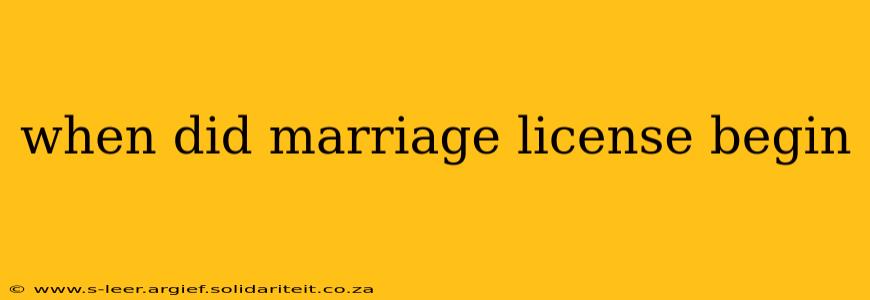The question of when marriage licenses began isn't as straightforward as it might seem. The concept of a formal, state-sanctioned marriage license evolved gradually over centuries, varying significantly across cultures and jurisdictions. Instead of a single starting point, we'll explore the historical development leading to the modern marriage license.
What is a Marriage License, and Why Do We Need One?
Before diving into history, let's define what a marriage license is. Essentially, it's a legal document issued by a government authority that grants permission for a couple to marry. This permission isn't about granting the right to marry itself (a fundamental human right), but rather it's a formal record of the intent to marry, ensuring compliance with state laws regarding marriage. These laws cover various aspects, including age requirements, blood relation prohibitions, and the validity of the marriage itself. The license ensures the marriage is legal and recorded, facilitating things like inheritance, child custody, and spousal benefits.
Early Forms of Marriage Recognition: Before Licenses
Long before formal marriage licenses, societies had various ways of recognizing and formalizing marital unions. These included:
- Religious Ceremonies: Many cultures relied on religious ceremonies to validate a marriage. The church (or other religious institution) played a significant role in establishing the legality and social acceptance of the union.
- Community Recognition: In some communities, the simple act of a couple living together and being accepted by the community was sufficient recognition of their marriage.
- Formal Contracts: In certain historical periods and contexts, marriages were formalized through written contracts, outlining the responsibilities and rights of both parties. This sometimes included details about dowries or property arrangements.
The Shift Towards State Control: The Rise of Civil Marriage
The gradual shift towards state control of marriage began centuries ago. While specific dates vary considerably by location, we can pinpoint key developments:
- The Protestant Reformation (16th Century): This religious upheaval challenged the Church's sole authority over marriage, leading to increasing involvement of secular authorities in regulating matrimonial affairs.
- Rise of Nation-States: The development of modern nation-states in the 17th and 18th centuries resulted in centralized governments seeking to control various aspects of life, including marriage.
- Development of Bureaucracy: The increased complexity of society and the expansion of government bureaucracies paved the way for standardized processes like the marriage license system.
When Did Marriage Licenses Become Common? A Graded Approach
Pinpointing a single date for the origin of marriage licenses is difficult because the process happened incrementally. Different jurisdictions adopted the system at different times, often influenced by local laws, religious beliefs, and social norms.
- United States: While early American colonies had some form of marriage regulation, the widespread adoption of the marriage license system occurred during the 19th century, gaining momentum in the late 1800s and early 1900s. The exact timing varied significantly from state to state.
- Europe: The development was similarly gradual, with many European countries establishing marriage license systems in the 19th and 20th centuries. The influence of Napoleonic Code played a significant role in the formalization of marriage laws in many European countries.
Why Did Marriage Licenses Become Necessary?
Several factors contributed to the need for marriage licenses:
- Proof of Marriage: Licenses provide verifiable proof of a legal marriage, crucial for legal and social recognition.
- Regulation of Marriage: They allow governments to regulate marriage, ensuring compliance with age requirements, blood relation limitations, and other legal aspects.
- Public Record Keeping: Licenses allow for the creation of a reliable public record of marriages, vital for various administrative and legal purposes.
- Taxation and Inheritance: The legal marriage facilitates the efficient administration of taxes and inheritance laws.
Are Marriage Licenses Always Required?
The answer is no. Even today, there are a few exceptions. Some indigenous communities may have alternative marriage systems, recognized by their own communities and sometimes by the state. However, the majority of marriages globally require some form of legal recognition, with a marriage license acting as the most common formal method.
In Conclusion: A Continuous Evolution
The history of marriage licenses is not marked by a single starting point but rather a gradual shift from religious and community-based recognition to state-controlled regulation. The development reflects broader historical changes in societal structure, government authority, and the ongoing evolution of legal systems across different regions.
